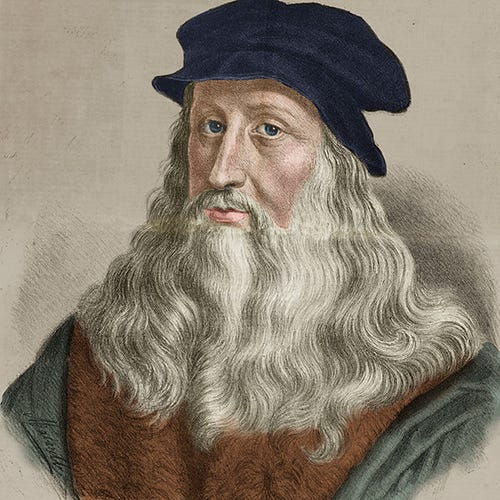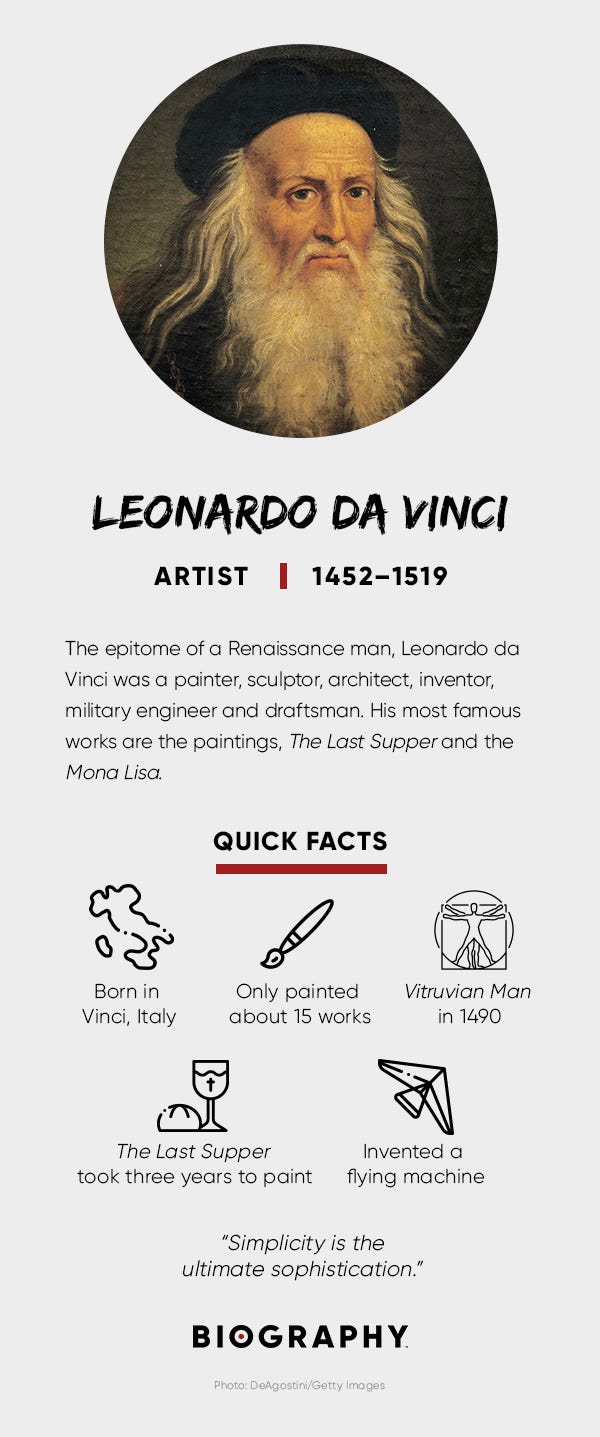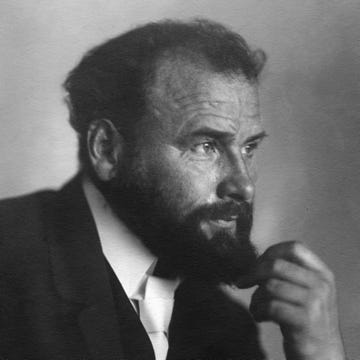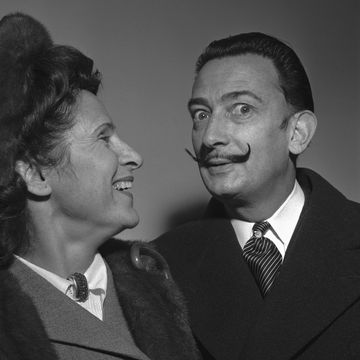(1452-1519)
Who Was Leonardo da Vinci?
Leonardo da Vinci was a Renaissance painter, sculptor, architect, inventor, military engineer and draftsman — the epitome of a true Renaissance man. Gifted with a curious mind and a brilliant intellect, da Vinci studied the laws of science and nature, which greatly informed his work. His drawings, paintings and other works have influenced countless artists and engineers over the centuries.
Early Life
Da Vinci was born in a farmhouse outside the village of Anchiano in Tuscany, Italy (about 18 miles west of Florence) on April 15, 1452.
Born out of wedlock to respected Florentine notary Ser Piero and a young peasant woman named Caterina, da Vinci was raised by his father and his stepmother.
At the age of five, he moved to his father’s estate in nearby Vinci (the town from which his surname derives), where he lived with his uncle and grandparents.
Education
Young da Vinci received little formal education beyond basic reading, writing and mathematics instruction, but his artistic talents were evident from an early age.
Around the age of 14, da Vinci began a lengthy apprenticeship with the noted artist Andrea del Verrocchio in Florence. He learned a wide breadth of technical skills including metalworking, leather arts, carpentry, drawing, painting and sculpting.
His earliest known dated work — a pen-and-ink drawing of a landscape in the Arno valley — was sketched in 1473.
Early Works
At the age of 20, da Vinci qualified for membership as a master artist in Florence’s Guild of Saint Luke and established his own workshop. However, he continued to collaborate with del Verrocchio for an additional five years.
It is thought that del Verrocchio completed his “Baptism of Christ” around 1475 with the help of his student, who painted part of the background and the young angel holding the robe of Jesus.
According to Lives of the Most Excellent Painters, Sculptors and Architects, written around 1550 by artist Giorgio Vasari, del Verrocchio was so humbled by the superior talent of his pupil that he never picked up a paintbrush again. (Most scholars, however, dismiss Vasari’s account as apocryphal.)
In 1478, after leaving del Verrocchio’s studio, da Vinci received his first independent commission for an altarpiece to reside in a chapel inside Florence’s Palazzo Vecchio.
Three years later the Augustinian monks of Florence’s San Donato a Scopeto tasked him to paint “Adoration of the Magi.” The young artist, however, would leave the city and abandon both commissions without ever completing them.
Was Leonardo da Vinci Gay?
Many historians believe that da Vinci was a homosexual: Florentine court records from 1476 show that da Vinci and four other young men were charged with sodomy, a crime punishable by exile or death.
After no witnesses showed up to testify against 24-year-old da Vinci, the charges were dropped, but his whereabouts went entirely undocumented for the following two years.
Several other famous Florentine artists were also known to have been homosexual, including Michelangelo, Donatello and Sandro Botticelli. Indeed, homosexuality was such a fact of artistic life in Renaissance Florence that the word "florenzer" became German slang for “gay.”
Leonardo da Vinci: Paintings
Although da Vinci is known for his artistic abilities, fewer than two dozen paintings attributed to him exist. One reason is that his interests were so varied that he wasn’t a prolific painter. Da Vinci’s most famous works include the “Vitruvian Man,” “The Last Supper” and the “Mona Lisa.”
Vitruvian Man
Art and science intersected perfectly in da Vinci’s sketch of “Vitruvian Man,” drawn in 1490, which depicted a nude male figure in two superimposed positions with his arms and legs apart inside both a square and a circle.
The now-famous sketch represents da Vinci's study of proportion and symmetry, as well as his desire to relate man to the natural world.
The Last Supper
Around 1495, Ludovico Sforza, then the Duke of Milan, commissioned da Vinci to paint “The Last Supper” on the back wall of the dining hall inside the monastery of Milan’s Santa Maria delle Grazie.
The masterpiece, which took approximately three years to complete, captures the drama of the moment when Jesus informs the Twelve Apostles gathered for Passover dinner that one of them would soon betray him. The range of facial expressions and the body language of the figures around the table bring the masterful composition to life.
The decision by da Vinci to paint with tempera and oil on dried plaster instead of painting a fresco on fresh plaster led to the quick deterioration and flaking of “The Last Supper.” Although an improper restoration caused further damage to the mural, it has now been stabilized using modern conservation techniques.
Mona Lisa
In 1503, da Vinci started working on what would become his most well-known painting — and arguably the most famous painting in the world —the “Mona Lisa.” The privately commissioned work is characterized by the enigmatic smile of the woman in the half-portrait, which derives from da Vinci’s sfumato technique.
Adding to the allure of the “Mona Lisa” is the mystery surrounding the identity of the subject. Princess Isabella of Naples, an unnamed courtesan and da Vinci’s own mother have all been put forth as potential sitters for the masterpiece. It has even been speculated that the subject wasn’t a female at all but da Vinci’s longtime apprentice Salai dressed in women’s clothing.
Based on accounts from an early biographer, however, the "Mona Lisa" is a picture of Lisa del Giocondo, the wife of a wealthy Florentine silk merchant. The painting’s original Italian name — “La Gioconda” — supports the theory, but it’s far from certain. Some art historians believe the merchant commissioned the portrait to celebrate the pending birth of the couple’s next child, which means the subject could have been pregnant at the time of the painting.
If the Giocondo family did indeed commission the painting, they never received it. For da Vinci, the "Mona Lisa" was forever a work in progress, as it was his attempt at perfection, and he never parted with the painting. Today, the "Mona Lisa" hangs in the Louvre Museum in Paris, France, secured behind bulletproof glass and regarded as a priceless national treasure seen by millions of visitors each year.
Battle of Anghiari
In 1503, da Vinci also started work on the "Battle of Anghiari," a mural commissioned for the council hall in the Palazzo Vecchio that was to be twice as large as "The Last Supper."
He abandoned the "Battle of Anghiari" project after two years when the mural began to deteriorate before he had a chance to finish it.
Inventions
In 1482, Florentine ruler Lorenzo de' Medici commissioned da Vinci to create a silver lyre and bring it as a peace gesture to Ludovico Sforza. After doing so, da Vinci lobbied Ludovico for a job and sent the future Duke of Milan a letter that barely mentioned his considerable talents as an artist and instead touted his more marketable skills as a military engineer.
Using his inventive mind, da Vinci sketched war machines such as a war chariot with scythe blades mounted on the sides, an armored tank propelled by two men cranking a shaft and even an enormous crossbow that required a small army of men to operate.
The letter worked, and Ludovico brought da Vinci to Milan for a tenure that would last 17 years. During his time in Milan, da Vinci was commissioned to work on numerous artistic projects as well, including “The Last Supper.”
Da Vinci’s ability to be employed by the Sforza clan as an architecture and military engineering advisor as well as a painter and sculptor spoke to da Vinci’s keen intellect and curiosity about a wide variety of subjects.
Flying Machine
Always a man ahead of his time, da Vinci appeared to prophesy the future with his sketches of devices that resemble a modern-day bicycle and a type of helicopter.
Perhaps his most well-known invention is a flying machine, which is based on the physiology of a bat. These and other explorations into the mechanics of flight are found in da Vinci's Codex on the Flight of Birds, a study of avian aeronautics, which he began in 1505.
Like many leaders of Renaissance humanism, da Vinci did not see a divide between science and art. He viewed the two as intertwined disciplines rather than separate ones. He believed studying science made him a better artist.
In 1502 and 1503, da Vinci also briefly worked in Florence as a military engineer for Cesare Borgia, the illegitimate son of Pope Alexander VI and commander of the papal army. He traveled outside of Florence to survey military construction projects and sketch city plans and topographical maps.
He designed plans, possibly with noted diplomat Niccolò Machiavelli, to divert the Arno River away from rival Pisa in order to deny its wartime enemy access to the sea.
Da Vinci’s Study of Anatomy and Science
Da Vinci thought sight was humankind’s most important sense and eyes the most important organ, and he stressed the importance of saper vedere, or “knowing how to see.” He believed in the accumulation of direct knowledge and facts through observation.
“A good painter has two chief objects to paint — man and the intention of his soul,” da Vinci wrote. “The former is easy, the latter hard, for it must be expressed by gestures and the movement of the limbs.”
To more accurately depict those gestures and movements, da Vinci began to study anatomy seriously and dissect human and animal bodies during the 1480s. His drawings of a fetus in utero, the heart and vascular system, sex organs and other bone and muscular structures are some of the first on human record.
In addition to his anatomical investigations, da Vinci studied botany, geology, zoology, hydraulics, aeronautics and physics. He sketched his observations on loose sheets of papers and pads that he tucked inside his belt.
Da Vinci placed the papers in notebooks and arranged them around four broad themes—painting, architecture, mechanics and human anatomy. He filled dozens of notebooks with finely drawn illustrations and scientific observations.
Sculptures
Ludovico Sforza also tasked da Vinci with sculpting a 16-foot-tall bronze equestrian statue of his father and founder of the family dynasty, Francesco Sforza. With the help of apprentices and students in his workshop, da Vinci worked on the project on and off for more than a dozen years.
Da Vinci sculpted a life-size clay model of the statue, but the project was put on hold when war with France required bronze to be used for casting cannons, not sculptures. After French forces overran Milan in 1499 — and shot the clay model to pieces — da Vinci fled the city along with the duke and the Sforza family.
Ironically, Gian Giacomo Trivulzio, who led the French forces that conquered Ludovico in 1499, followed in his foe’s footsteps and commissioned da Vinci to sculpt a grand equestrian statue, one that could be mounted on his tomb. After years of work and numerous sketches by da Vinci, Trivulzio decided to scale back the size of the statue, which was ultimately never finished.
Final Years
Da Vinci returned to Milan in 1506 to work for the very French rulers who had overtaken the city seven years earlier and forced him to flee.
Among the students who joined his studio was young Milanese aristocrat Francesco Melzi, who would become da Vinci’s closest companion for the rest of his life. He did little painting during his second stint in Milan, however, and most of his time was instead dedicated to scientific studies.
Amid political strife and the temporary expulsion of the French from Milan, da Vinci left the city and moved to Rome in 1513 along with Salai, Melzi and two studio assistants. Giuliano de’ Medici, brother of newly installed Pope Leo X and son of his former patron, gave da Vinci a monthly stipend along with a suite of rooms at his residence inside the Vatican.
His new patron, however, also gave da Vinci little work. Lacking large commissions, he devoted most of his time in Rome to mathematical studies and scientific exploration.
After being present at a 1515 meeting between France’s King Francis I and Pope Leo X in Bologna, the new French monarch offered da Vinci the title “Premier Painter and Engineer and Architect to the King.”
Along with Melzi, da Vinci departed for France, never to return. He lived in the Chateau de Cloux (now Clos Luce) near the king’s summer palace along the Loire River in Amboise. As in Rome, da Vinci did little painting during his time in France. One of his last commissioned works was a mechanical lion that could walk and open its chest to reveal a bouquet of lilies.
How Did Leonardo da Vinci Die?
Da Vinci died of a probable stroke on May 2, 1519, at the age of 67. He continued work on his scientific studies until his death; his assistant, Melzi, became the principal heir and executor of his estate. The “Mona Lisa” was bequeathed to Salai.
For centuries after his death, thousands of pages from his private journals with notes, drawings, observations and scientific theories have surfaced and provided a fuller measure of the true "Renaissance man."
Book and Movie
Although much has been written about da Vinci over the years, Walter Isaacson explored new territory with an acclaimed 2017 biography, Leonardo da Vinci, which offers up details on what drove the artist's creations and inventions.
The buzz surrounding the book carried into 2018, with the announcement that it had been optioned for a big-screen adaptation starring Leonardo DiCaprio.
Salvator Mundi
In 2017, the art world was sent buzzing with the news that the da Vinci painting "Salvator Mundi" had been sold at a Christie's auction to an undisclosed buyer for a whopping $450.3 million. That amount dwarfed the previous record for an art work sold at an auction, the $179.4 million paid for “Women of Algiers" by Pablo Picasso in 2015.
The sales figure was stunning in part because of the damaged condition of the oil-on-panel, which features Jesus Christ with his right hand raised in blessing and his left holding a crystal orb, and because not all experts believe it was rendered by da Vinci.
However, Christie's had launched what one dealer called a "brilliant marketing campaign," which promoted the work as "the holy grail of our business" and "the last da Vinci." Prior to the sale, it was the only known painting by the old master still in a private collection.
The Saudi Embassy stated that Prince Bader bin Abdullah bin Mohammed bin Farhan al-Saud of Saudi Arabia had acted as an agent for the ministry of culture of Abu Dhabi, in the United Arab Emirates. Around that time, the newly-opened Louvre Abu Dhabi announced that the record-breaking artwork would be exhibited in its collection.
"],["
"],["
"]]" tml-render-layout="inline">
QUICK FACTS
- Name: Leonardo da Vinci
- Birth Year: 1452
- Birth date: April 15, 1452
- Birth City: Vinci
- Birth Country: Italy
- Gender: Male
- Best Known For: Leonardo da Vinci was a Renaissance artist and engineer, known for paintings like "The Last Supper" and "Mona Lisa,” and for inventions like a flying machine.
- Industries
- Art
- Science and Medicine
- Writing and Publishing
- Architecture
- Technology and Engineering
- Astrological Sign: Aries
- Nacionalities
- Italian
- Interesting Facts
- Leonardo da Vinci was born out of wedlock to a respected Florentine notary and a young peasant woman.
- Da Vinci used tempera and oil on dried plaster to paint "The Last Supper," which led to its quick deterioration and flaking.
- For da Vinci, the "Mona Lisa" was forever a work in progress, as it was his attempt at perfection, and he never parted with the painting.
- Death Year: 1519
- Death date: May 2, 1519
- Death City: Amboise
- Death Country: France
Fact Check
We strive for accuracy and fairness.If you see something that doesn't look right,contact us!
CITATION INFORMATION
- Article Title: Leonardo da Vinci Biography
- Author: Biography.com Editors
- Website Name: The Biography.com website
- Url: https://www.biography.com/artists/leonardo-da-vincii
- Access Date:
- Publisher: A&E; Television Networks
- Last Updated: August 28, 2019
- Original Published Date: April 3, 2014
QUOTES
- Iron rusts from disuse, stagnant water loses its purity and in cold weather becomes frozen; even so does inaction sap the vigor of the mind.
- Nothing is hidden beneath the sun.
- Obstacles cannot bend me. Every obstacle yields to effort.
- We make our life by the death of others.
- Necessity is the mistress and guardian of nature.
- One ought not to desire the impossible.
- He who neglects to punish evil sanctions the doing thereof.
- Darkness is the absence of light. Shadow is the diminution of light.
- The painter who draws by practice and judgment of the eye without the use of reason, is like the mirror that reproduces within itself all the objects which are set opposite to it without knowledge of the same.
- He who does not value life does not deserve it.
- Simplicity is the ultimate sophistication.
- Nothing strengthens authority so much as silence.













